Health Sciences: Ethical Issues, Research Analysis, and Case Studies
VerifiedAdded on 2023/06/07
|6
|1040
|232
Homework Assignment
AI Summary
This Health Sciences assignment solution addresses various aspects of healthcare and research ethics. It begins by discussing the role of the Institutional Review Board (IRB) in ensuring ethical human research practices. The assignment then critiques the unethical Tuskegee Syphilis Experiment, highlighting its violations of informed consent and denial of treatment. It further debunks the myth of needing eight glasses of water daily, tracing its origins to misinterpretations of earlier health recommendations. The solution also outlines the phases of clinical trials and evaluates the credibility and limitations of a study on human activity using smartphone data. It condemns the unethical use of Henrietta Lacks' cells and discusses conflict of interest in the context of Dr. Holick's promotion of vitamin D. Desklib offers more solved assignments and study resources for students.
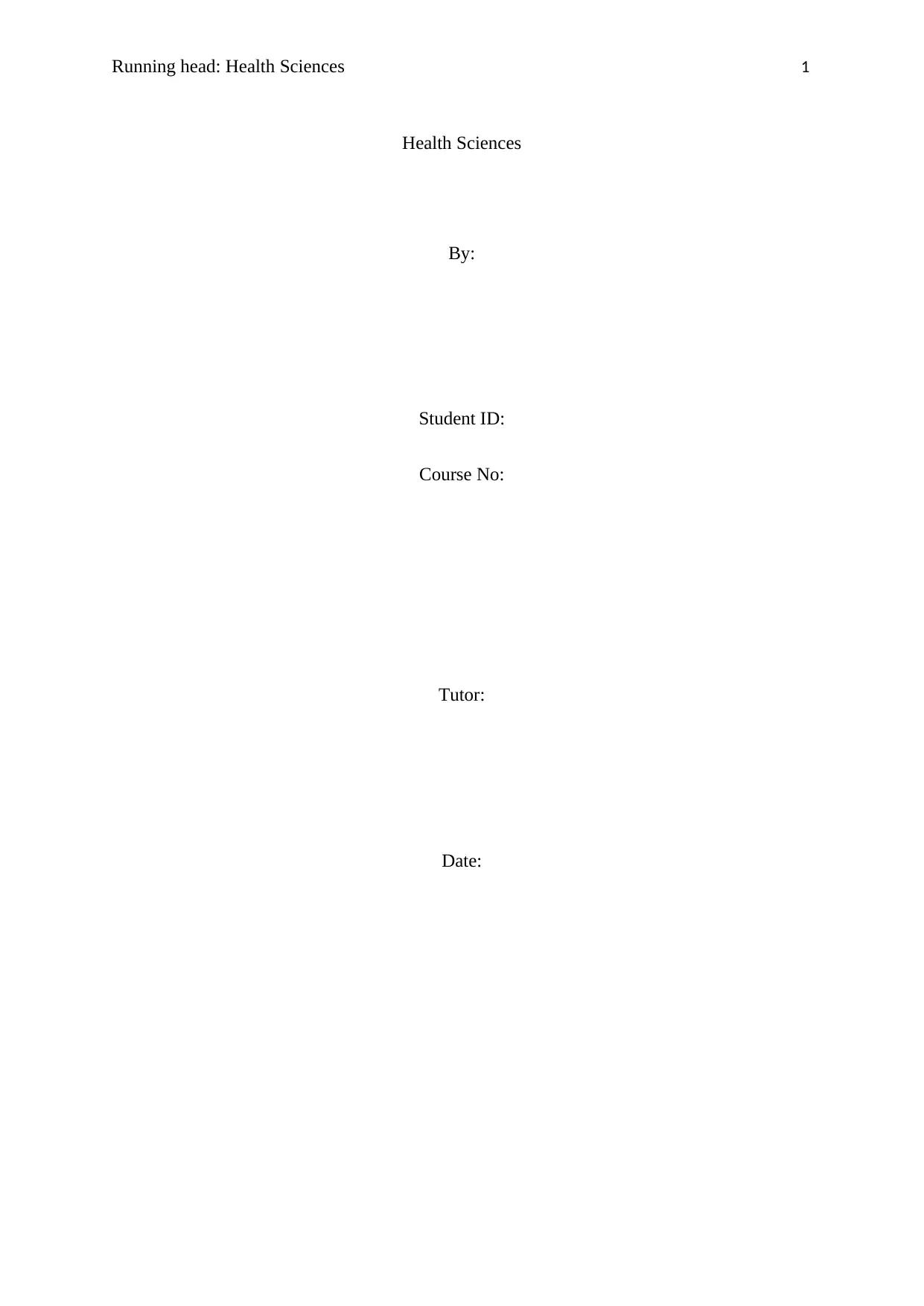
Running head: Health Sciences 1
Health Sciences
By:
Student ID:
Course No:
Tutor:
Date:
Health Sciences
By:
Student ID:
Course No:
Tutor:
Date:
Paraphrase This Document
Need a fresh take? Get an instant paraphrase of this document with our AI Paraphraser
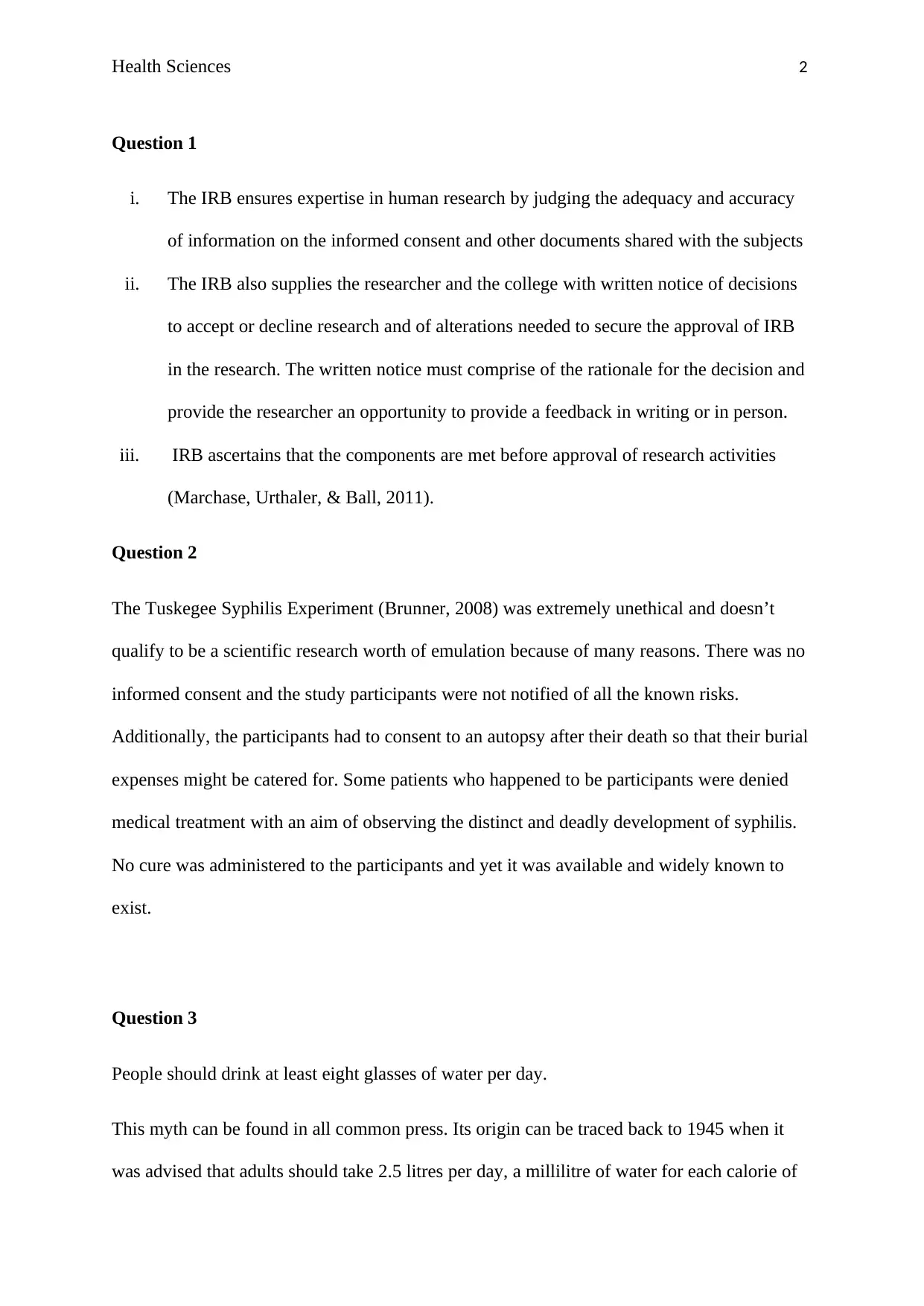
Health Sciences 2
Question 1
i. The IRB ensures expertise in human research by judging the adequacy and accuracy
of information on the informed consent and other documents shared with the subjects
ii. The IRB also supplies the researcher and the college with written notice of decisions
to accept or decline research and of alterations needed to secure the approval of IRB
in the research. The written notice must comprise of the rationale for the decision and
provide the researcher an opportunity to provide a feedback in writing or in person.
iii. IRB ascertains that the components are met before approval of research activities
(Marchase, Urthaler, & Ball, 2011).
Question 2
The Tuskegee Syphilis Experiment (Brunner, 2008) was extremely unethical and doesn’t
qualify to be a scientific research worth of emulation because of many reasons. There was no
informed consent and the study participants were not notified of all the known risks.
Additionally, the participants had to consent to an autopsy after their death so that their burial
expenses might be catered for. Some patients who happened to be participants were denied
medical treatment with an aim of observing the distinct and deadly development of syphilis.
No cure was administered to the participants and yet it was available and widely known to
exist.
Question 3
People should drink at least eight glasses of water per day.
This myth can be found in all common press. Its origin can be traced back to 1945 when it
was advised that adults should take 2.5 litres per day, a millilitre of water for each calorie of
Question 1
i. The IRB ensures expertise in human research by judging the adequacy and accuracy
of information on the informed consent and other documents shared with the subjects
ii. The IRB also supplies the researcher and the college with written notice of decisions
to accept or decline research and of alterations needed to secure the approval of IRB
in the research. The written notice must comprise of the rationale for the decision and
provide the researcher an opportunity to provide a feedback in writing or in person.
iii. IRB ascertains that the components are met before approval of research activities
(Marchase, Urthaler, & Ball, 2011).
Question 2
The Tuskegee Syphilis Experiment (Brunner, 2008) was extremely unethical and doesn’t
qualify to be a scientific research worth of emulation because of many reasons. There was no
informed consent and the study participants were not notified of all the known risks.
Additionally, the participants had to consent to an autopsy after their death so that their burial
expenses might be catered for. Some patients who happened to be participants were denied
medical treatment with an aim of observing the distinct and deadly development of syphilis.
No cure was administered to the participants and yet it was available and widely known to
exist.
Question 3
People should drink at least eight glasses of water per day.
This myth can be found in all common press. Its origin can be traced back to 1945 when it
was advised that adults should take 2.5 litres per day, a millilitre of water for each calorie of
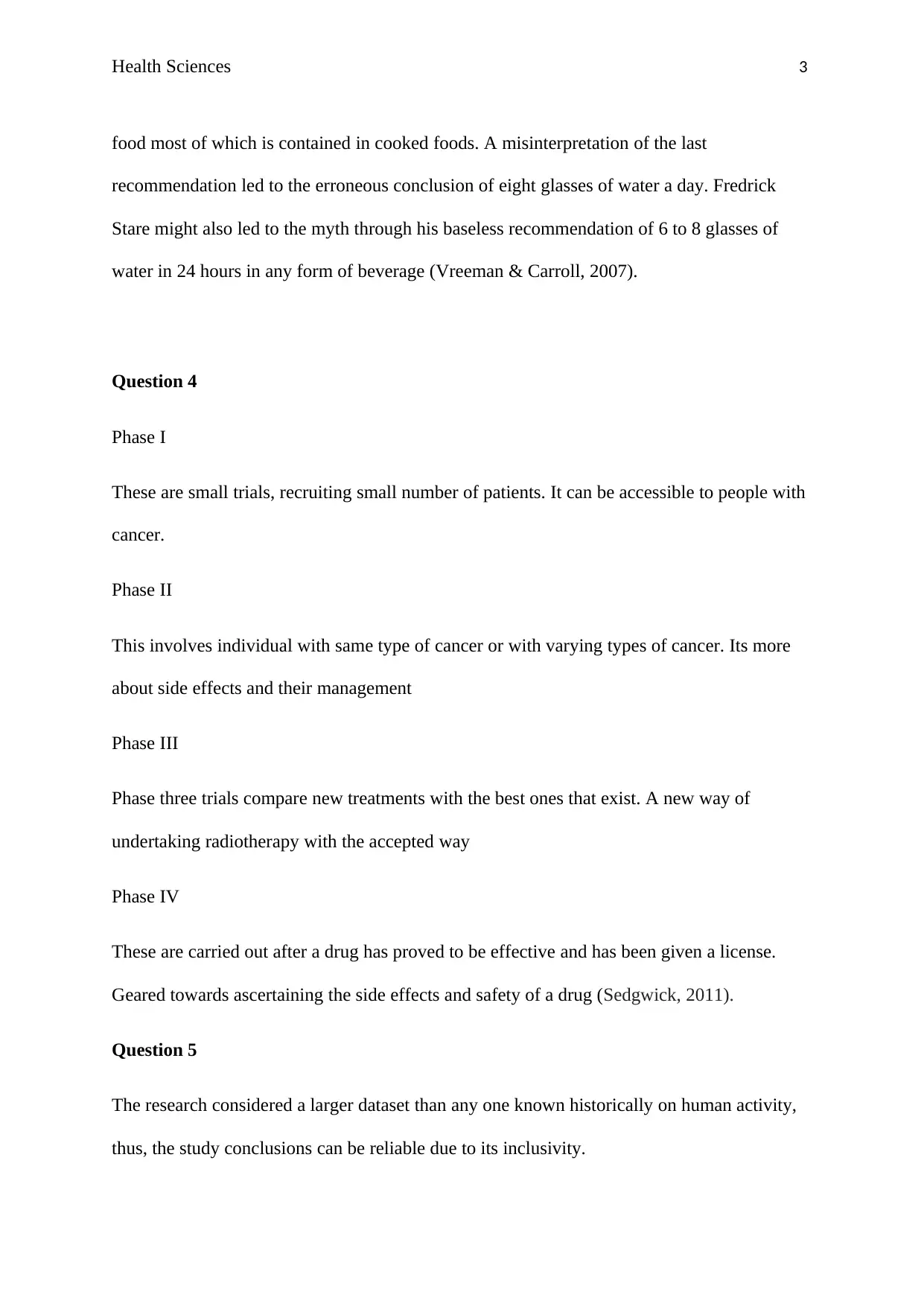
Health Sciences 3
food most of which is contained in cooked foods. A misinterpretation of the last
recommendation led to the erroneous conclusion of eight glasses of water a day. Fredrick
Stare might also led to the myth through his baseless recommendation of 6 to 8 glasses of
water in 24 hours in any form of beverage (Vreeman & Carroll, 2007).
Question 4
Phase I
These are small trials, recruiting small number of patients. It can be accessible to people with
cancer.
Phase II
This involves individual with same type of cancer or with varying types of cancer. Its more
about side effects and their management
Phase III
Phase three trials compare new treatments with the best ones that exist. A new way of
undertaking radiotherapy with the accepted way
Phase IV
These are carried out after a drug has proved to be effective and has been given a license.
Geared towards ascertaining the side effects and safety of a drug (Sedgwick, 2011).
Question 5
The research considered a larger dataset than any one known historically on human activity,
thus, the study conclusions can be reliable due to its inclusivity.
food most of which is contained in cooked foods. A misinterpretation of the last
recommendation led to the erroneous conclusion of eight glasses of water a day. Fredrick
Stare might also led to the myth through his baseless recommendation of 6 to 8 glasses of
water in 24 hours in any form of beverage (Vreeman & Carroll, 2007).
Question 4
Phase I
These are small trials, recruiting small number of patients. It can be accessible to people with
cancer.
Phase II
This involves individual with same type of cancer or with varying types of cancer. Its more
about side effects and their management
Phase III
Phase three trials compare new treatments with the best ones that exist. A new way of
undertaking radiotherapy with the accepted way
Phase IV
These are carried out after a drug has proved to be effective and has been given a license.
Geared towards ascertaining the side effects and safety of a drug (Sedgwick, 2011).
Question 5
The research considered a larger dataset than any one known historically on human activity,
thus, the study conclusions can be reliable due to its inclusivity.
⊘ This is a preview!⊘
Do you want full access?
Subscribe today to unlock all pages.

Trusted by 1+ million students worldwide
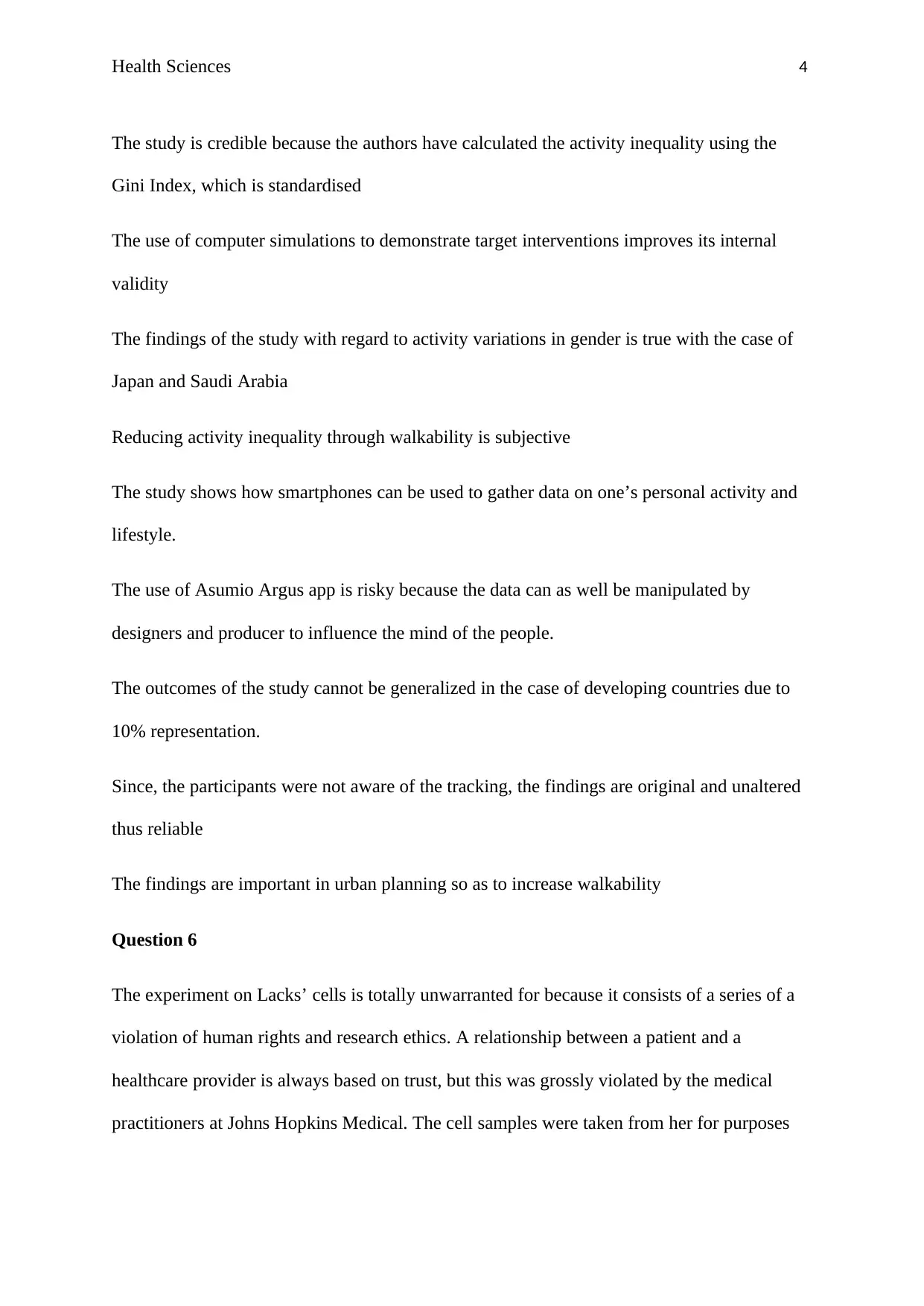
Health Sciences 4
The study is credible because the authors have calculated the activity inequality using the
Gini Index, which is standardised
The use of computer simulations to demonstrate target interventions improves its internal
validity
The findings of the study with regard to activity variations in gender is true with the case of
Japan and Saudi Arabia
Reducing activity inequality through walkability is subjective
The study shows how smartphones can be used to gather data on one’s personal activity and
lifestyle.
The use of Asumio Argus app is risky because the data can as well be manipulated by
designers and producer to influence the mind of the people.
The outcomes of the study cannot be generalized in the case of developing countries due to
10% representation.
Since, the participants were not aware of the tracking, the findings are original and unaltered
thus reliable
The findings are important in urban planning so as to increase walkability
Question 6
The experiment on Lacks’ cells is totally unwarranted for because it consists of a series of a
violation of human rights and research ethics. A relationship between a patient and a
healthcare provider is always based on trust, but this was grossly violated by the medical
practitioners at Johns Hopkins Medical. The cell samples were taken from her for purposes
The study is credible because the authors have calculated the activity inequality using the
Gini Index, which is standardised
The use of computer simulations to demonstrate target interventions improves its internal
validity
The findings of the study with regard to activity variations in gender is true with the case of
Japan and Saudi Arabia
Reducing activity inequality through walkability is subjective
The study shows how smartphones can be used to gather data on one’s personal activity and
lifestyle.
The use of Asumio Argus app is risky because the data can as well be manipulated by
designers and producer to influence the mind of the people.
The outcomes of the study cannot be generalized in the case of developing countries due to
10% representation.
Since, the participants were not aware of the tracking, the findings are original and unaltered
thus reliable
The findings are important in urban planning so as to increase walkability
Question 6
The experiment on Lacks’ cells is totally unwarranted for because it consists of a series of a
violation of human rights and research ethics. A relationship between a patient and a
healthcare provider is always based on trust, but this was grossly violated by the medical
practitioners at Johns Hopkins Medical. The cell samples were taken from her for purposes
Paraphrase This Document
Need a fresh take? Get an instant paraphrase of this document with our AI Paraphraser
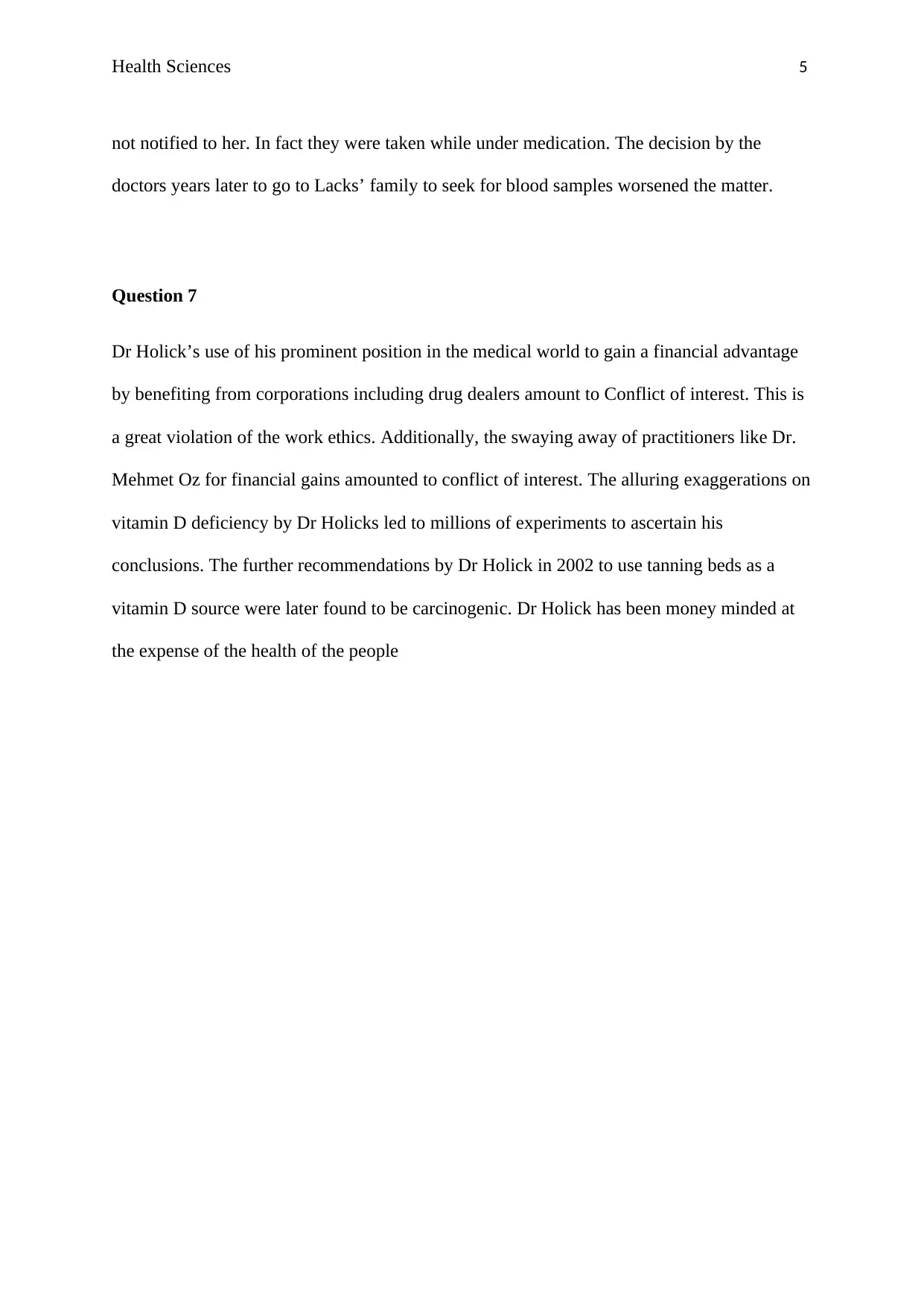
Health Sciences 5
not notified to her. In fact they were taken while under medication. The decision by the
doctors years later to go to Lacks’ family to seek for blood samples worsened the matter.
Question 7
Dr Holick’s use of his prominent position in the medical world to gain a financial advantage
by benefiting from corporations including drug dealers amount to Conflict of interest. This is
a great violation of the work ethics. Additionally, the swaying away of practitioners like Dr.
Mehmet Oz for financial gains amounted to conflict of interest. The alluring exaggerations on
vitamin D deficiency by Dr Holicks led to millions of experiments to ascertain his
conclusions. The further recommendations by Dr Holick in 2002 to use tanning beds as a
vitamin D source were later found to be carcinogenic. Dr Holick has been money minded at
the expense of the health of the people
not notified to her. In fact they were taken while under medication. The decision by the
doctors years later to go to Lacks’ family to seek for blood samples worsened the matter.
Question 7
Dr Holick’s use of his prominent position in the medical world to gain a financial advantage
by benefiting from corporations including drug dealers amount to Conflict of interest. This is
a great violation of the work ethics. Additionally, the swaying away of practitioners like Dr.
Mehmet Oz for financial gains amounted to conflict of interest. The alluring exaggerations on
vitamin D deficiency by Dr Holicks led to millions of experiments to ascertain his
conclusions. The further recommendations by Dr Holick in 2002 to use tanning beds as a
vitamin D source were later found to be carcinogenic. Dr Holick has been money minded at
the expense of the health of the people
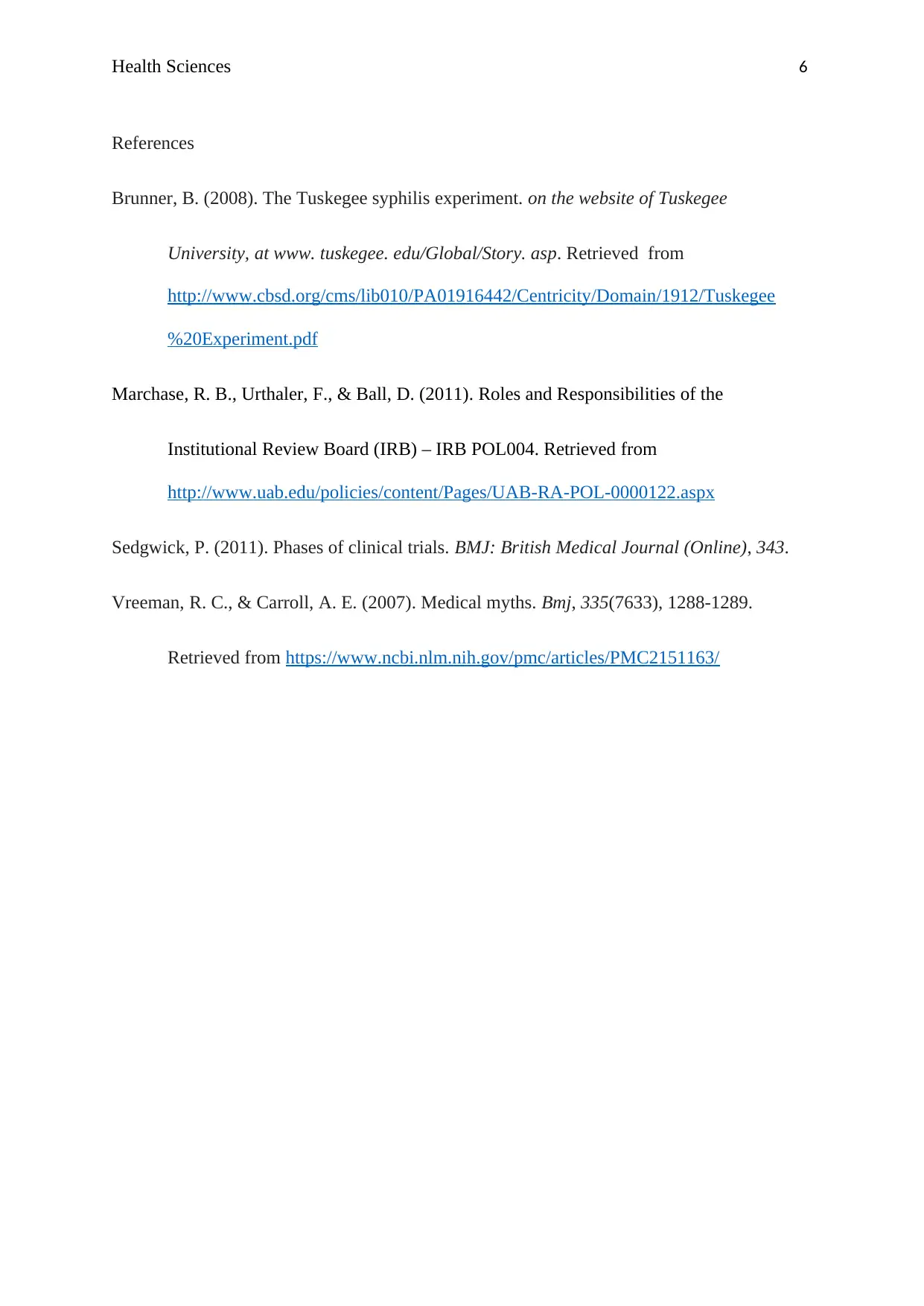
Health Sciences 6
References
Brunner, B. (2008). The Tuskegee syphilis experiment. on the website of Tuskegee
University, at www. tuskegee. edu/Global/Story. asp. Retrieved from
http://www.cbsd.org/cms/lib010/PA01916442/Centricity/Domain/1912/Tuskegee
%20Experiment.pdf
Marchase, R. B., Urthaler, F., & Ball, D. (2011). Roles and Responsibilities of the
Institutional Review Board (IRB) – IRB POL004. Retrieved from
http://www.uab.edu/policies/content/Pages/UAB-RA-POL-0000122.aspx
Sedgwick, P. (2011). Phases of clinical trials. BMJ: British Medical Journal (Online), 343.
Vreeman, R. C., & Carroll, A. E. (2007). Medical myths. Bmj, 335(7633), 1288-1289.
Retrieved from https://www.ncbi.nlm.nih.gov/pmc/articles/PMC2151163/
References
Brunner, B. (2008). The Tuskegee syphilis experiment. on the website of Tuskegee
University, at www. tuskegee. edu/Global/Story. asp. Retrieved from
http://www.cbsd.org/cms/lib010/PA01916442/Centricity/Domain/1912/Tuskegee
%20Experiment.pdf
Marchase, R. B., Urthaler, F., & Ball, D. (2011). Roles and Responsibilities of the
Institutional Review Board (IRB) – IRB POL004. Retrieved from
http://www.uab.edu/policies/content/Pages/UAB-RA-POL-0000122.aspx
Sedgwick, P. (2011). Phases of clinical trials. BMJ: British Medical Journal (Online), 343.
Vreeman, R. C., & Carroll, A. E. (2007). Medical myths. Bmj, 335(7633), 1288-1289.
Retrieved from https://www.ncbi.nlm.nih.gov/pmc/articles/PMC2151163/
⊘ This is a preview!⊘
Do you want full access?
Subscribe today to unlock all pages.

Trusted by 1+ million students worldwide
1 out of 6
Your All-in-One AI-Powered Toolkit for Academic Success.
+13062052269
info@desklib.com
Available 24*7 on WhatsApp / Email
![[object Object]](/_next/static/media/star-bottom.7253800d.svg)
Unlock your academic potential
© 2024 | Zucol Services PVT LTD | All rights reserved.